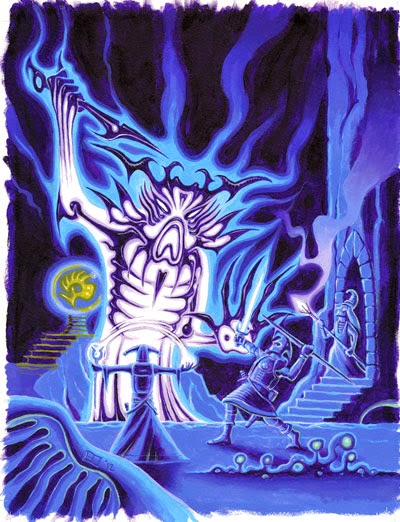Slavery is often referred to in fantasy role playing games, FRPG’s, as evil. However, the scale of good/evil and how each game nation or culture views slavery would vary, as it did from ancient to modern times. Usually, on nine point alignment systems, chaotic good is viewed as opposed to slavery, while lawful good might be accepting of it, provided the methods of slavery and treatment of slaves falls within what is culturally and legally acceptable. This topic is touchy and some people see the word and might choose to think I am saying that I am in favor of slavery. I am merely discussing it from a gaming perspective. It is generally understood that the bad guys, such as orcs, keep slaves. Some human groups might keep slaves. I begin with some questions, a brief historical and cultural review, and conclude with some thoughts for informing slavery. This article was spurred by the directions of my thoughts on this post. This is not a high scholarly article, only the briefest of overviews that touches on some general ideas. [For the record, in the real world, I think slavery is an evil, nasty practice, that should end. Many think that slavery ended over a century ago, but there are still people suffering in slavery today. If you have a problem with simulated slavery in the imagination, and don’t have a problem with all the imaginary killing, you have a logical disconnect. If you want to end slavery, go track down the jerks who BUY the slaves, thus making a market for the product. If there is no demand for slaves, it will end.]
Does or did slavery exist in your world? Is slavery more akin to some aspects of antiquity, where some or all slaves had certain rights and could somehow expect to return to or gain their freedom? Or is it more like more recent examples of slavery, where slaves are absolutely property to the point that their descendants are slaves, and their treatment varies by who their masters and overseers are? Would there be state slaves doing the work projects of the state? Would slaves be limited to conquered peoples, i.e. war prisoners, or criminals? What kinds of crimes would relegate one to slavery? Would all nations keep slaves, or only the most “primitive”, “evil”, or some such? Would slavery be such that even predominately good nations have slaves?
In the Bible, the Old Testament version of slavery was a form debt relief, or could be voluntary. Slavery was to be limited to six years, and then they were to be free, unless the master provided a wife during that time, then the male slave could opt to stay with his family and become a slave forever. The slave then was to have his ear pierced with an awl as a mark of his status. Women were not able to become free after six years, like men. Fathers could sell their daughters, but the master had to deal fairly with her. The only exception to this, was the year of Jubilee, every 50 years all slaves were to be set free and all debts forgiven. That was the law, but so far as we know, the ancient Israelites never did this. Those who were not Hebrews, however, were treated as we usually understand slaves. One can see how this informed the English concept of indentured servitude in colonial America.
Debt slavery is a way for one to get out of a hole by giving their labor for a set term in exchange for the master paying off their debts. This is related to voluntary slavery where someone becomes a slave so that someone else has to worry about where their food, clothing, and shelter comes from. This might be common in times of Indentured servitude, like was used by many young men from England and the German states to pay for passage to the English colonies in North America. It is estimated that between one third and one half of white males who came to the American colonies between about 1630 and the American Revolution were indentured servants. Indentured servants and their bond holders each had responsibilities to uphold. If an indentured servant ran off, they were found and sent back to finish out their term. Some bonds were re-sold, mid term, and the servant was stuck in perpetual indenturement, thus becoming a slave for life. Colonial apprenticeship programs where a master craftsman took on someone as an apprentice was much like indentured servitude, and could be initiated to bring the person to the colonies or for someone already in the colonies to get into a trade. This system could, of course, be abused, and apprentices ran away, much like other indentured servants. I did not find information on this with a quick google search, just going from memory from past history classes.
The first Africans brought to the American colonies in 1619 were indentured servants, because they had been baptized and were Christian, English law forbade enslaving Christians. So until 1640, African brought to the British Colonies were indentured servants, and not chattel slaves. Early on, slaves in North America could save up and buy their freedom, but that soon changed.
In antiquity, there was all variation of slavery. Slaves could be very well educated and entrusted with the education of the master’s children. Slaves could also be the ones doing dangerous and difficult jobs, such as mining underground.
Often, the largest supplies of slaves in antiquity were prisoners of war, that is, soldiers captured in battle after their defeat by the Roman Legions. At times, the Romans enslaved entire populations. Such slaves were sold to bring money into the state coffers. The needs of the state were maintained by keeping a portion of the slaves for government jobs. Famous examples of roman slaves are gladiators, who could win their freedom, such as Spartacus, famous for leading a slave revolt. See the movie with Kirk Douglas, or if you have cable, the TV series Spartacus.
In feudal Europe, there were varying levels or grades of serfs. In England, for example, there were four types of serfs, the lowest of which were actually slaves. Serfdom faded in Western Europe between the 14th and 16th centuries, and lasted in the Russian Empire until 1866.
The behavior and attitude of slaves is dependent upon their treatment. Underfed, poorly clothed and sheltered slaves who are mistreated become a powder keg and are ripe for revolt against their masters at the provocation that becomes the last straw. Some slave revolts, like that of Spartacus, come very near to reaching their goal of freedom, but usually, they end in a lot of death for the slaves, and sever punishments for those left behind to knock them back into compliance.
In my the online AD&D game I play in on Wednesday nights, the players discovered a conspiracy between powerful factions in two cities on the island, and we managed to expose it and end it, or at least drive off the slavers or send them underground. Obviously, this means in this case, that slavery is a no no. This need not be the default case in all games.
In my AD&D campaign, slavery only exists among the bad guys, however, I can see that it could be a normal part of life in another part of my world, if it even got developed.
If you have slavery in your world, here are some things to consider. NOTE: This assumes a human-centric world and a human government, from my interpretation. If you have a game where another race is in charge, the same questions need to be considered.
How does one become a slave?
- Losing side of battle or war
- Born into slavery
- Debt/Indentured/Voluntary
- Punishment for Crime(s)
Who can own slaves?
- King/State/Government
- Approved groups, like temples, military, certain types of industry, etc.
- Anyone who can afford it?
What form does slavery take?
- Temporary/Indentured for a set time.
- Permanent, but with possibility to save up and buy freedom, AKA redemption.
- Permanent, for life and descendants are born into slavery.
- This can take the form of no one can free a slave.
- A master can free, manumit, a slave.
- A slave can do something heroic and earn freedom.
- Perhaps a ruler or a deity could decree that it ends.
Who can become a slave?
- Anyone
- Only those born to a lowly caste/social class.
- Only prisoners of war.
- Criminals (types of crimes eligible would vary from any crime, to only the most severe, like murder)
- Only non humans
- Only those who don’t worship deity X
Who/What can end the institution of slavery?
- Nothing – That’s just the way it is
- Decree by ruler or representative of the main deity of the area.
- War
- Divine intervention – not likely, put possible.
Questions to consider:
Who is going to pay for this? Owners of slaves don’t want to just give up their property rights and inherent economic power, capital, tied up in their slaves.
Can the ones making the decree back it up with enforcement?
What jobs do slaves perform?
- Any job
- Any job designated as a slave job – Varies by nation/culture
- Skilled craftsmen
- Soldiers (sailors)
- Teachers of children
- Entertainers
- Only manual/menial labor
- Mining
- Galley Slaves (rowers)
- Farming
- Working with dangerous substances (poisonous, explosive, corrosive, etc.)
Social Strata
- Social Class, Loose – Possibility of moving up or down the ladder: money, valor, honor, connections, etc.
- Social Class, Rigid – Remote possibility of moving up or down the ladder: something exceptional, saving the king, defeating a powerful enemy, etc.
- Caste System – One is born into one’s station and there is no chance of movement, barring overthrow of that system. Becoming a slave in this system is a big deal, you upset the apple cart.
- If one does something to become a slave, they are the lowest of the low.
- OR, slaves stay in their caste, but no longer have the same rights and freedoms of others.
How does a slave become free?
- Never, or completion of contract if indentured.
- Manumission by master.
- Save up and buy freedom – Redemption.
- Earn it by deed(s).
- Freed by victorious army, ruler, etc.
- Run away and get clear of the slave chasers.
- Slave revolt
Trivia: I came across a term in the Midkemia Press, Cities book, “coffle” – a line of slaves or animals fastened together. This gives me the image of old pictures and movies about processions through the jungle. Coffle is from the Arabic word for caravan.







